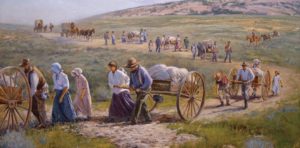 I always look for the prepper applications in day to day life; and so here is a little food for thought. I started thinking about bug out transportation problems on a trip to Southern California some years ago. I noticed how quickly the few major roads out of the LA area can slow down to gridlock for dozens or even hundreds of miles, and problems with both fuel and food supply en route following a normal holiday weekend; returning from a Christmas trip we found pumps drying up and food running short.
I always look for the prepper applications in day to day life; and so here is a little food for thought. I started thinking about bug out transportation problems on a trip to Southern California some years ago. I noticed how quickly the few major roads out of the LA area can slow down to gridlock for dozens or even hundreds of miles, and problems with both fuel and food supply en route following a normal holiday weekend; returning from a Christmas trip we found pumps drying up and food running short.
In a disaster situation, I realized one of the possible options for my wife’s family to get out of the death trap that is LA, would be on foot and north through the foothills and mountains. East would only take them to the desert, west would only put them in more urban areas or bring them to the sea; North and South along the highway again put them through vastly populated regions that could quickly become unsafe. They don’t have a boat, though I suppose they could acquire one, so what does that leave?
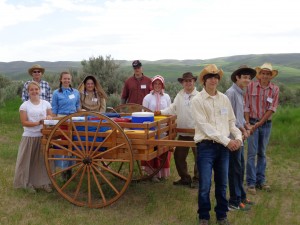
Assuming you are dressed for the weather, the two great disadvantages to bugging out on foot are speed and weight capacity. Unfortunately a handcart won’t do much for speed; but carrying capacity is drastically increased. I thought about these on a hand cart trek. Granted we were taking these handcarts up and down mountain trails that no logical pioneer would intentionally follow to teach us about the hardships suffered by many early pioneers coming out west, but it got the wheels in my head turning. Every situation is different, and maybe and handcart is something worth considering for your bugout plan. It is much more efficient than shopping carts sported by the homeless and some disaster movies. With a little modification to the wheels you could even have one to pull down the railroad tracks, if that is your preferred route. The axle width can also differ depending on the quality of roads or trails being used. Again, my experience showed that even steel rimmed wheels could navigate some rough country and many streams.
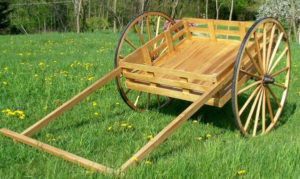
The Mormon pioneers made the hand cart famous in the mid-1800s. The handcarts resembled a large wheelbarrow, with two wheels five feet (1.5 m) in diameter and a single axle four and a half feet (1.4 m) wide, and weighing 60 pounds (27 kg) unburdened. Running along each side of the bed were seven-foot (2.1 m) pull shafts ending with a three-foot (0.9 m) crossbar at the front. The crossbar allowed the carts to be pushed or pulled. Cargo was carried in a box about three feet by four feet (0.9 m by 1.2 m), with 8 inch (0.2 m) walls. The handcarts generally carried up to 250 pounds (110 kg) of supplies and luggage, though they were capable of handling loads as heavy as 500 pounds (230 kg). Carts used in the first year’s migration were made entirely of wood (“Iowa hickory or oak”); in later years a stronger design was substituted, which included metal elements.
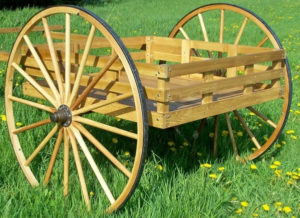
The weight capacity depends not only on construction, but also on load distribution. If you properly balance the weight over the axle you can obviously carry much more weight at greater ease. The same principle applies when you use a dolly to lift heavy furniture and rock it back until the weight is over the axle and can be moved with relative ease. Modern materials also let us construct handcarts stronger and lighter than their predecessors.
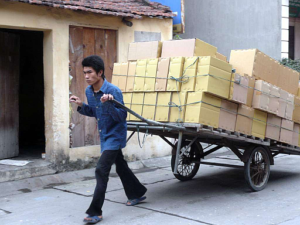
Mormons have always been notorious for organizations, and the westbound immigrants were no exception. Military type organization and discipline was common with many handcart and wagon companies along all the westbound trails in the 1800s. The Mormon handcart companies were organized using the handcarts and sleeping tents as the primary units. Five persons were assigned per handcart, with each individual limited to 17 pounds (7.7 kg) of clothing and bedding. Each round tent, supported by a center pole, housed 20 occupants and was supervised by a tent captain. Five tents were supervised by the captain of a hundred (or “sub-captain”). Provisions for each group of one hundred emigrants were carried in an ox wagon, and were distributed by the tent captains.
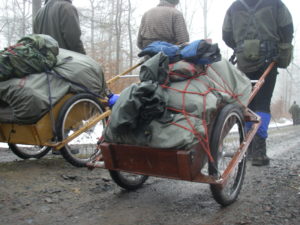
Experience on my trek revealed that with a five person team, or a family as a team, rotations can be taken pulling and pushing the cart. If two people pull at the same time try and match height for greater comfort. The rest walk alongside the cart, or push from the back when necessary. For extra carrying capacity packs could still be used if needed.
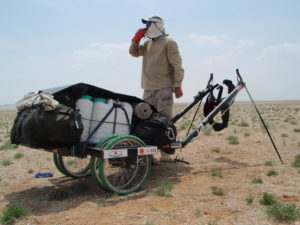
Handcart travel had distinct limitations: handcarts transported less food than wagons and hardly any clothing and bedding; propelling the carts was hard physical work, especially when going up or down hill or when pulling on sandy or muddy roads; many carts required repairs or broke down; during daytime the travelers had no protection from sun, and day and night they lacked protection from bad weather. As a result, some judged the handcart experience more harshly than others. Hannah Lapish, for example, who, with her husband, pulled two young children to Utah in the ninth handcart company, considered handcarts to be a “most pathetic mode of traveling.”
At a city square one group of handcart pullers stopped, received a formal greeting, and pitched their tents, ending their 1,300-mile journey. Though fatigued, they had completed the journey with less mortality than was the average for ox-trains. Often they had traveled 25 to 30 miles per day. They had demonstrated the practicality of men and women crossing the Plains pulling their own baggage in handcarts, a first in the history of organized overland travel.
Covered wagon trains in the old West, on the other hand, generally only traveled one to two miles per hour, or the equivalent of a toddler’s walking speed. They could go about a hundred miles in a seven-day week of travel, but many devout people refused to travel on Sunday, slowing them down even further.
The Ellsworth, McArthur, and Bunker companies covered the 1,031 miles from Florence to Salt Lake City in an average of 65 days, which was 12 days faster than three wagon trains that year that covered the same distance in an average of 77 days. Hence, the handcart system shaved a week to ten days off the travel time. Had they not been slowed down by their ox-drawn support wagons, they could have traveled even faster.

There are some pretty fancy modern versions of handcarts used all over the world even today. This is not the preferred form of travel over motorized vehicles, or possibly even bicycles; but its worth a nod.
Jon
The Annals of Iowa Volume 65, Number 2 (Spring 2006 pps. 101-123
How fast could covered wagon trains travel in the old West? July 18, 2014 by Karen Hill | Filed Under: History

Leave a Reply